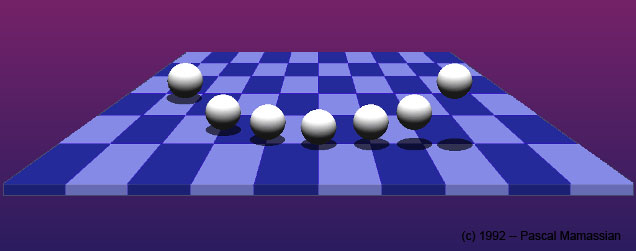Spatial Layout from Cast Shadows

The balls on the left appear to rest on
the checkerboard whereas the ones on the right appear to float in the
air. This difference in perception is purely due to the location of
their respective shadows that are either touching the balls (on the
left) or detached from the balls (on the right). Indeed, in the image,
the balls on the left are exactly at the same height as the ones on the
right. This illusion is even more striking in a motion equivalent of
the figure. It illustrates the importance of cast shadows for the
perception of the spatial layout of objects in a three-dimensional
scene.
Collaborators:
Daniel
Kersten, David Knill and Isabelle Bülthoff.
Further
references:
Mamassian, P.,
Kersten, D. and Knill, D. C. (1992). Spatial layout from cast shadows.
Abstract of oral presentation at ARVO (Sarasota, Florida). Investigative Ophtalmology and Visual
Science, 32, 1179.
Kersten, D., Knill, D. C., Mamassian, P. and Bülthoff, I.
(1996). Illusory motion from shadows. Nature, 379, 31.
Kersten, D., Mamassian, P. and Knill, D. C. (1997). Moving cast
shadows induce apparent motion in depth. Perception, 26, 171-192.
Mamassian, P., Knill, D. C. and Kersten, D. (1998). The perception
of cast shadows. Trends in
Cognitive Sciences, 2,
288-295.
Notes on the
figure:
The
figure on this page was created by Pascal Mamassian in 1992 as a
stationary equivalent of the shadow movie he produced and presented at
the ARVO scientific conference in 1992. The figure served for some time
as the logo of Dan Kersten's laboratory at the University of Minnesota
where Pascal Mamassian did his PhD. Permission is hereby granted for
non-profit education purposes as long as proper credit to Pascal
Mamassian is provided.
Back
to Pascal's homepage
